Aug 19 2009
A Little Goes a Long Way: Petit Verdot
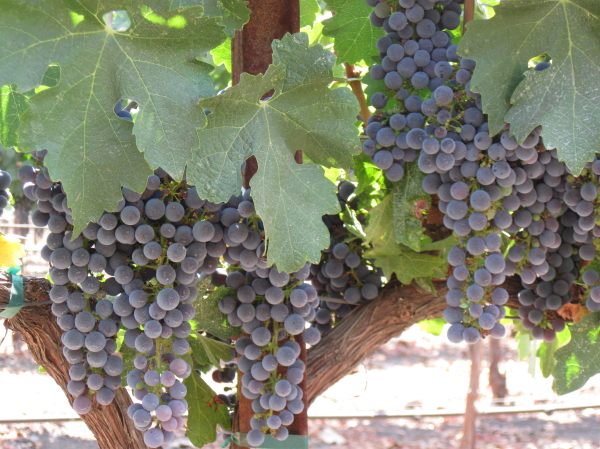
Napa’s warm days are growing shorter and its evening cool coastal breezes are arriving earlier and gracing the late afternoon. The hint of cool marine breeze combined with warm late summer afternoon sun reminds Napa Valley’s residents that autumn is just around the corner. With thoughts of autumn in mind, wine connoisseurs affectionately dream of red wines with baited anticipation: for as the temperature cools, the appeal of red wines increases. Before you rush to reach for a Cabernet Sauvignon, there is one unique red wine (which if made well), will impress anyone who tastes it. This wine is Petit Verdot.
As Petit Verdot is poured into a wine glass, it immediately captures your attention. It is inky and exhibits a rich, dark purple color. Still cloaked in mystery, it gives off the appearance of substance even though not a drop has been tasted and the bouquet has not yet been smelled.
So what is Petit Verdot?
Petit Verdot, despite its exotic name, is not a foreign grape to many palates. The grape is a red wine grape and is often referred to as a “blending grape”. As a “blending grape”, Petit Verdot notably contributes to a wine as it adds spice, color, tannins, and some attitude with its flavor. It is suspected to originally hail from the Bordeaux region of France and appropriately found in small percentages in “Bordeaux Blend” red wines. Since the grape is known for contributing structure, Petit Verdot is often found added to many a Cabernet Sauvignon thereby giving the wine more presence as it crosses your mid-palate. It is apparent that a little bit of Petit Verdot goes a long way in blended wines but surprisingly it is sometimes found made well in a wine on its own.
Petit Verdot is not often found made into its own wine as it is a difficult grape to grow. Despite its Bordeaux origins, the grape does not grow particularly well in that region or cooler climates. The grape is slow to ripen, often ripening after the early fall harvest of other grapes such as Cabernet Sauvignon. Given that it prefers heat, winemakers in California (given the state’s climate) are finding success with Petit Verdot. One winery in particular that produces a stand-out Petit Verdot is Markham Vineyards (“Markham”).
Pouring Markham’s Petit Verdot into a glass immediately passes the sight test. Inky and dark purple in its coloring, this Petit Verdot lumbers into the glass giving the appearance of a thick, rich red wine. As you draw your nose close to the glass, you are not overwhelmed with bright or jammy fruit. Instead, the Petit Verdot’s mysterious appearance teases your nose and requires you to investigate further into the top of the glass to smell and decipher its bouquet. At first sniff, this wine is different and complex. The bouquet of the wine provides aromas of dark fruit like blackberry and black currant, prominent leather, a hint of smoke and a bit of spice. Tilting the glass, the wine does not disappoint your palate upon its first introduction. All of the aromas in the bouquet of Markham’s Petit Verdot find their respective place on your palate in a harmonious balance. Sensually, the wine is thick, rich and velvety. In short, this is a lusty wine and worthy of a similar food pairing.
Given that Markham’s Petit Verdot is dominated by blackberry and black currant flavors, my inclination is to pair this wine with pork given its innate ability to pair well with slightly tart fruit. Noting the spices in the wine and its rich velvet sensual nature, there is no doubt that this wine will pair well with a slow-cooked meal, particularly one which includes garlic. Keeping these elements in mind, for this wine and food pairing, I elected to prepare:
1) Roasted Tomatillo Salsa;
2) Slow-cooked Pork Carnitas Tacos; and
3) Cuban Black Beans and Brown Rice.
Creating a Roasted Tomatillo Salsa to pair with Carnitas Tacos is simple and brings together elements of sweetness and spice. Included in the recipe for the salsa is garlic (which is also an ingredient in the pork and the black beans later) which creates a warm spice that matches perfectly with the spices found in Markham’s Petit Verdot. Also, while making the salsa, I elected to roasted my tomatillos and jalapenos to mirror the hint of smoke that I found in the wine. The sweetness of the tomatillos is crucial in two respects. First, the tomatillos will not overpower the flavor of the pork in the Carnitas Tacos. Second, this same sweetness helps to balance out any tartness from the blackberry or currant flavors in the wine.
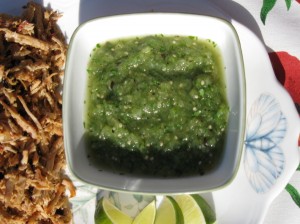
While you could roast your cut of pork, using a Crockpot to slow-cook ensures that your seasonings have plenty of time to marry, and creates a juicy piece of pork which shreds effortlessly. This also means that there is no reason not to use a lean cut of pork if you are using the Crockpot. Again, garlic is a key ingredient to this recipe (which ties into the wine). Once the pork is shredded, chop some sweet onion to garnish on top of the tacos with a dash of lime and serve the tomatillo salsa.
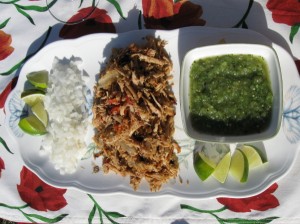
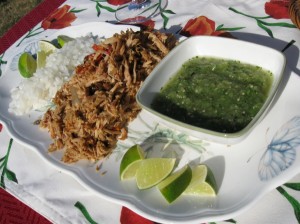
Cuban black beans and brown rice are a nice balanced side to the Carnitas Tacos. The warm spices in this dish pair innately with the spices in the Petit Verdot.

Putting all of these items together creates a meal equally lusty to the Petit Verdot paired alongside. The meal, while lusty, does not leave one feeling over-stuffed. And the Petit Verdot? Opening it and allowing it to decant an hour or so before the meal is recommended to experience all of its attributes. It is a wine that is not in a hurry and likewise is best sipped alongside the meal. Its alcohol content is 14.9% which means that a little bit of this wine will go a long way. Given the complex sensual nature of Petit Verdot, sitting back and sipping this wine with a slow-cooked meal is a blissful way to beckon autumn forth.
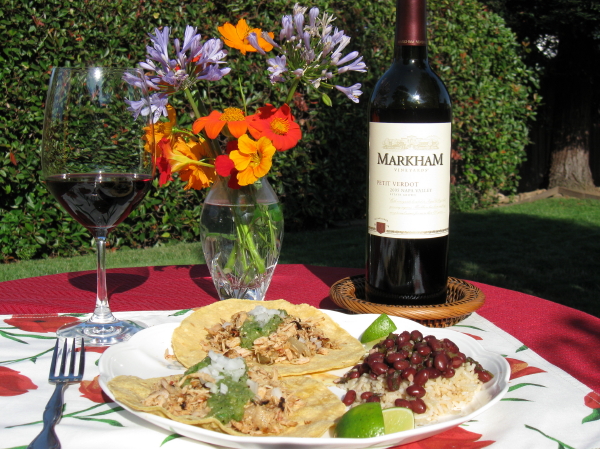
Comments Off on A Little Goes a Long Way: Petit Verdot